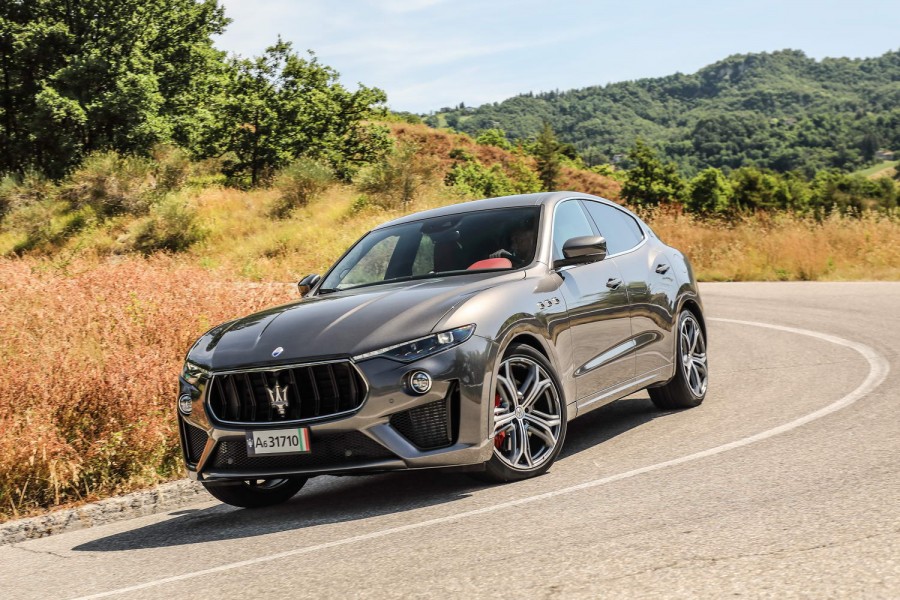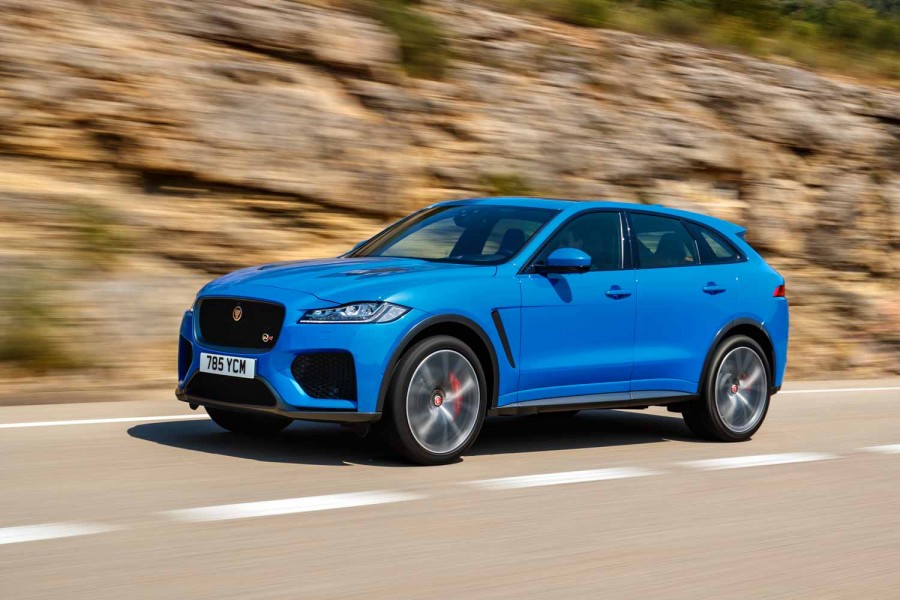Maserati is moving its performance SUV game up a notch with the introduction of the Levante GTS. Under the bonnet lies a twin-turbocharged V8 petrol engine producing 530hp with power going to all four wheels. Still want that Porsche Cayenne Turbo?
In the metal
With the introduction of the V8 engine to the range, only minor exterior changes differentiate this Maserati Levante GTS from its V6-powered relations, beyond the GTS badging on the rear. A new honeycomb mesh design behind the front bumper sections, along with 'air blades', bring a further degree of purpose to the Levante.
The iconic Maserati trident symbol adorns the sizeable open grille that features eight vertical double bars. One layer deeper lies a set of shutters for the engine bay that remain closed upon start-up to help bring the V8 up to operating temperature more quickly, thus reducing emissions, while also aiding aerodynamics on the move. Six-piston Brembo monobloc brake callipers painted in a bright red lurk behind 21-inch alloy wheels and Maserati equips the Levante GTS with bi-Xenon headlights as standard. Optionally, buyers can add matrix LED units that are claimed to offer a 20 per cent increase in visibility.
Somewhat expectedly for such a car, the interior is a blend of sporty design and luxury materials. The sports seats are firm, offering a good deal of adjustability, and though they aren't very heavily bolstered, they do a reasonable job of holding you in place during more spirited driving. The steering wheel can adjust for both height and reach. Behind it are two large fixed paddles for when you want to shift gear manually. They're well finished, tactile and easy to find and use. One minor niggle is that the left paddle does leave the stalk behind it, which controls wiper functions, slightly hidden from view and less easy to reach.
Drive control functions run along the side the centre console next to a small rotary controller for some of the infotainment system's features. Gloss carbon fibre inserts cover the top, a detail that carries thought to the doors and the dashboard. The 8.4-inch touchscreen display might not have the most modern interfaces, but it is easy and intuitive to use. Navigation prompts can also be shown on the smaller TFT display between the instrument dials.
Driving it
Maserati is a marque that understands design and performance, but it also appreciates theatre. Perhaps not to the same degree as its Lamborghini neighbours from up the road in Sant'Agata, but thumbing the engine start button on the Levante GTS will put a smile on your face even on the dullest of mornings. The V8 barks into life through the quad exhausts before settling into a fast, purposeful idle.
The Levante GTS has a power output of 530hp at a heady 6,250rpm, while peak torque of 730Nm arrives at 2,500rpm and runs through to 5,000rpm. In everyday driving, that means the engine rarely spins past 3,000rpm in any legal scenario. Plenty of sound insulation around the cabin maintains a fair degree of refinement, too. When you push on beyond 3,500rpm, the setup of the exhaust does change, developing into a more sonorous engine note that is simply gorgeous. One thing you notice is that all the engine noise is behind you - Maserati doesn't employ any sound fakery inside the cabin, so everything you hear is the real deal. Some people may prefer more of that V8 soundtrack inside the car, but Maserati describes it as something of a trade-off between having a great sounding exhaust, but not a loud engine droning in the cabin during a long motorway journey, and in this type of application it's the right way to do it, we feel.
As with all of Maserati's petrol engines, the V8 is assembled by Ferrari in Maranello, and it does share some core architecture with the unit Ferrari uses, but it is entirely bespoke in the Levante with twin-scroll turbochargers that can feed up to 200kg/hr of air to the engine. The power unit also gets different camshafts, valves, cylinder heads, conrods and pistons to the Ferrari engine, along with new software mapping to achieve. When Maserati initially conceived the Levante there wasn't a plan to fit a V8 engine, so one of the other challenges in squeezing the larger power unit in was redesigning the crankcase and repositioning the oil pump and electrical hardware to accommodate the drive shafts to the front axle for the all-wheel-drive system. The excellent ZF eight-speed automatic is employed here.
The Levante GTS sends 100 per cent of the engine's torque to the rear wheels in normal driving conditions. There is a mechanical limited-slip differential at the rear axle and in more slippery conditions the transmission can shunt 50 per cent of torque to the front axle in a claimed 150 milliseconds. Lean on it even more and the Q4 all-wheel-drive system implements its torque vectoring function by applying braking force to individual wheels to maintain the chosen driving line.
It is surprising at just how user-friendly the Levante GTS is when driving harder. During some wet conditions the power delivery is seldom interrupted by any of the driver assistance systems. Powering out of slow-speed hairpin corners slingshots you on to the next apex without so much as a twitch from the rear end and seemingly regardless of surface conditions. Considering its 2,170kg weight, the six-piston Brembo brakes do a decent job of hauling up the GTS, though we would prefer if there were slightly more feel through the brake pedal. Only during heavier braking and the latter third of pedal travel do you feel them begin to bite hard.
For a tall SUV, the handling, while not razor-sharp, does a good job of masking the car's mass. The air suspension has six different settings that can alter the ride height across a 75mm spectrum. The suspension provides a reasonably comfortable ride quality in everyday use, even with larger 21-inch wheels fitted. When left in its normal driving mode, the experience is pleasant. Ample torque levels and the eight-speed transmission make the everyday commute easy and the creature comforts inside, along with that cabin refinement we mentioned earlier, give the Levante GTS some enamouring qualities.
What you get for your money
The Maserati Levante GTS is quite well-equipped. Standard features include a specific front grille, metallic paint and 21-inch alloy wheels. Inside, there is a Harman/Kardon stereo system, heated front seats and steering wheel, leather upholstery throughout and an infotainment system that includes Android Auto and Apple CarPlay smartphone connectivity, along with a reversing camera.
Summary
As a fast SUV goes, the Maserati Levante GTS delivers performance on a par with some of the best in the segment. What sets it apart isn't just the outright pace but the overall driving experience it delivers. The evocative soundtrack is every bit as intoxicating as the blunt-force acceleration. Engines like this aren't much longer for this world in the present guise, so lap it up while you can.






























